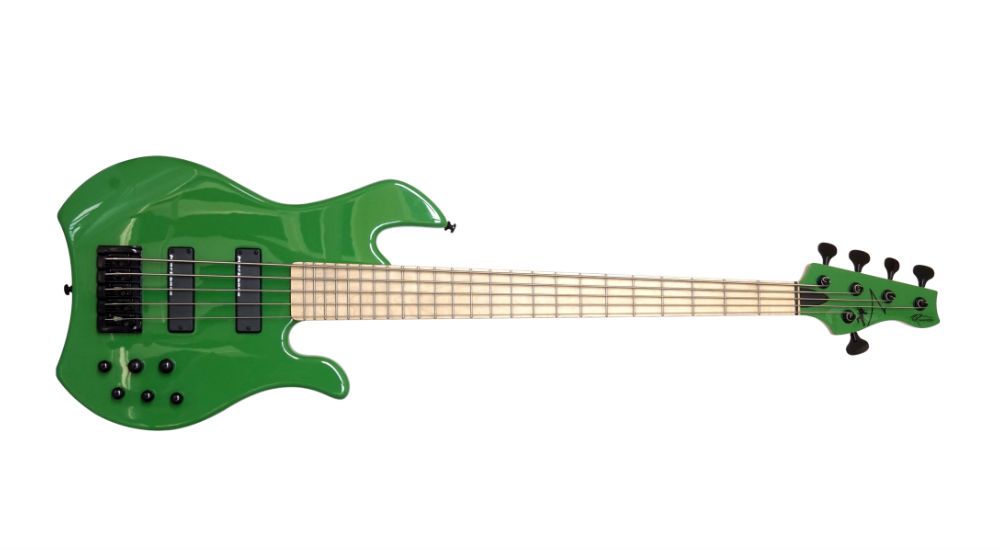Markbass have applied every ounce of their trademark creativity and precision to come out with the Kimandu 5 Richard Bona Signature, a truly unique and resounding debut. It features a two-piece alder body with a 38mm thick, bolt-on Canadian Maple neck. The fretboard measures out to 34” (or around 86cm) long, with 24 frets which means a more physically-accessible upper register. It has two Markbass custom ‘soapbar’ pickups, a bridge which is also custom made. These are accompanied by zinc saddles, which aim to realise greater sustain from the instrument. You’ve got two volume dials (one for each pickup) and a tone control that allows you to toggle between active and passive settings. The smaller dials behind the volume are your EQs: one each for bass, mids and treble.
Upon just taking this bass out of its case for the first time, I was impressed by its featherweight. From my experience, I’ve usually found active basses to be slightly heavier just because of the electronics contained inside, however this is certainly not the case with the Kimandu 5. The weight is distributed evenly between the neck and the body – embedded inside the neck are two graphite truss rods, which provide a sturdy yet lightweight spine that runs through the instrument. The contour is thoughtfully designed, with the cutaway allowing for easy access to frets 18 and beyond, for those who enjoy the odd solo. The Green finish is another nice, slightly quirky addition to the aesthetic of the bass. For those who aren’t too keen on the Green, there’s also Old Red, Old Yellow and Artisan Silver colour schemes to choose from.
I played the Kimandu 5 through my trusty Markbass Nano + Traveller 102P cab, and the sound was something to behold. While the bass is both active and passive, I spent the majority of my time utilising the active settings, due to the greater range of tonal possibilities. I wanted to test out the Kimandu 5’s low-end tones to start off with, so naturally I boosted the bass EQ whilst dialling back the mids and trebles. Jamming to D’Angelo’s ‘Spanish Joint’, I was really happy with how unobtrusively well the bass sat within the mix: it’s perceptible, but because the Kimandu 5’s tone is so dynamically even all-round, it doesn’t sound too boomy or overpowering in the midst of the other instruments. The bass’s capacity for sustain is impressive: if you’re playing a bass part that requires a more minimalistic, ‘less is more’, approach, sustain is essential.
I then dialled up the mids and treble for want of a more sculpted ‘studio’ tone, before tackling Nathan Watts’ legendary bass part on Stevie’s ‘Sir Duke’. This is where the bass really shines, in my opinion; the tone is full and bitey, without sounding even slightly tinny. For those of you who aren’t familiar with the tune, there is a fairly intricate piece of passagework that recurs throughout the song. Instances like this made me appreciate the Kimandu 5’s neck cutaway, making it heaps easier for me to reach those high notes with my left hand. It’s also a sensational slap bass. Bowie’s ‘Let’s Dance’ sounded a treat, with those descending slapped notes coming through nice and punchy, without drowning the mix in a sea of treble. While I’m personally not heavily reliant on the low B string, it holds up quite well on this bass, and comes in handy if you need to hit the E flat every now and again.
The Kimandu 5 is well set up, with no discernible buzzes or intonation problems. I did notice that I found myself tuning the bass a bit more frequently than I usually would, possibly due to the fresh set-up and new set of strings, but that’s all part of the fun with a new instrument. The passive tone is fairly standard, but again, it’s really the active tone that makes the Kimandu 5 what it is. I personally believe that, at its current price point, it’s a worthwhile purchase given the sheer quality of tones it offers, not to mention its lightweight and original design. A truly sensational debut from Markbass.

